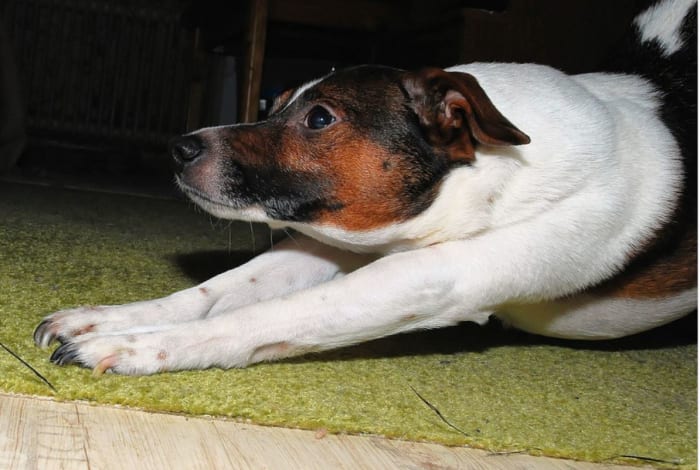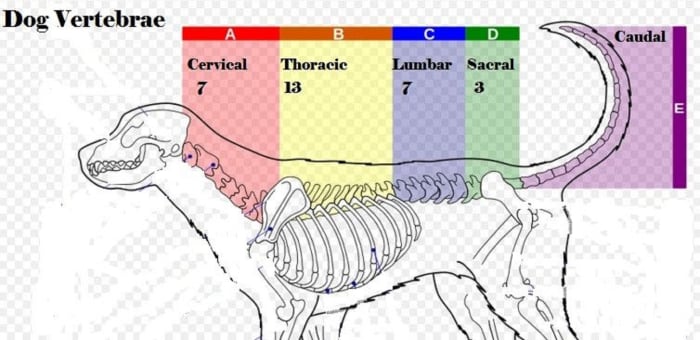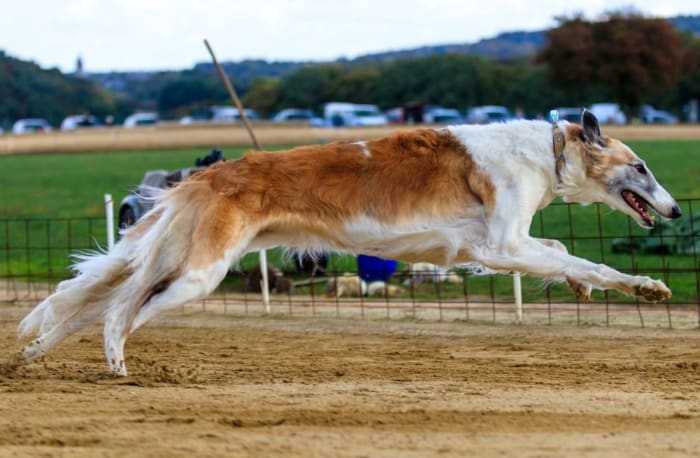What Does Oft Mean if My Dog Is Arching Back
When dogs arch their backs, dog owners are often baffled by this behavior. One may assume, that just like cats, dogs must arch their backs for the purpose of appearing larger and more intimidating.
However, it turns out, when a dog arches his back and acts abnormally, one of the first and foremost concerns should be evaluating the possibility of an underlying health problem.
Following are several potential causes for dogs arching their backs, from medical issues to psychological ones, and even some peculiar breed-specific traits.
Dogs Arching Their Backs When Waking Up
It's called the "greeting stretch" and it's often carried out when dogs are waking up from a nap and walking your way, looking at you.
Brenda Aloff, in the book "Canine Body Language, A Photographic Guide, describes this form of stretching as "a posture used only towards someone the dog likes and with whom he is comfortable."
When dogs perform the greeting stretch, their ears are relaxed and they often show soft, squinty eyes pointing towards the owner.
The posture involves lowering of the dog's front legs, while their back legs are raised leading eventually to an arched back. The front legs are often lined up together, but the elbows don't touch the floor.
Dogs stretch and arch their backs when waking up because it feels good and helps relax their tightened muscles after a period of inactivity.
It goes without saying that this type of back arching is nothing to worry about as long as it happens in context with waking up and doesn't occur repeatedly or with your dog showing signs of discomfort.

The "greeting stretch" is often seen when dogs wake up from a nap.
Dog Arching Back When Being Pet
Sometimes, dogs may arch their back when being pet. This can be a sign that your dog is itchy and is hoping you reach a particularly itchy or painful spot.
It may be worthy inspecting your dog's fur in case there are signs of fleas such as the presence of flea dirt.
While you are at it, look for any reddened areas or signs of irritation. If the area is red or irritated, or your dog shows signs of pain, you may want to check with your vet and prevent your dog from licking or scratching the area as it can make matters worse.
Dog Arching Back When "Excited"
It's called "air humping" and it may look quite dirty or taboo from a human perspective. Basically, the dog arches his back as he performs several pelvic thrusting motions that mimic what happens when dogs are "manufacturing a batch of puppies" so to say.
However, what makes this behavior interesting, is the fact that spayed female dogs, male neutered dogs and even young puppies are often seen doing the humping, and not only, the humping motions rather than being directed towards a female dog in heat can be directed towards other dogs (regardless of gender), people legs', objects (pillows, stuffed animals) and sometimes even the air!
Many dog owners are indeed often surprised to learn that the first humping episodes happen quite early in puppies, at an age we would expect puppies to play with butterflies and chase toilet paper rolls down a flight of stairs.
Intrigued? More on this behavior is covered here: why in the world do dogs hump the air?
A Matter of Pain
In a healthy dog, the back in general tends to be straight from shoulder to tail. When a dog holds his back arched, veterinarians call this posture " kyphosis" which is meant to depict an abnormally rounded back.
Why do dogs assume this arched-up posture? According to NeuroPetVet, a website created and maintained by Dr. Mark Troxel, a board-certified veterinary neurologist, this position helps alleviate discomfort which may be localized in the dog's neck or back.
Because this position relieves the dog's aches, using this posture is reinforcing to the dog so he'll tend to rely on this alternate position for as long as the pain is there. Let's take a closer look into this.
A Spinal Issue
A dog's spine is composed by several small bones known as vertebrae. Between the vertebrae are several 'intervertebral disks' which are meant to cushion and provide flexibility to the dog's neck, spine, and tail.
In a dog with a perfect spine, the disks do what they were meant to do, allowing the dog to engage in day-to-day activities with no problems.
However, when a dog ages or through trauma, the disks are prone to rupture or herniate causing pressure on the spinal cord. Affected dogs may therefore develop what vets refer to as a "pinched nerve" or herniated disk in the dog's neck or middle or lower back.
When the disk is inflamed, it puts pressure on the dog's spinal nerves which is something quite painful, causing the dog to arch its back and likely also cry out in pain, along with keeping the head lowered and becoming reluctant to move, explains veterinarian Dr. Jeff.
Discovering How Dogs React to Fog
How dogs react to fog is an interesting query considering how fog envelops everything and how dogs are prone to use their powerful senses to explore the world around them. In order to better understand how dogs react to fog, it therefore helps better understanding how fog works and how it impacts dogs.
Why Do Wet Dog Noses Smell Better?
Wet dog noses smell better simply because of how odor molecules respond to moisture. This is of course the short answer. The longer answer requires us to discover how a dog's nose works and how odor molecules react to when they meet a dog's wet nose.
Why Do Dogs Rub Their Faces?
Many dogs rub their faces, but there is face rubbing and face rubbing in dogs. While the occasional face rub may be normal, excessive face rubbing in dogs warrants a trip to the determine what may be going on. Veterinarian Dr. Jennifer Masucci shares possible causes of excessive face rubbing in dogs.
Such dogs may also be hesitant to go up or down stairs, and on and off furniture, adds veterinary technician Julie Ann from Vet Info.
When vets suspect a spinal problem, they may perform some neurological tests and manipulate each vertebrae for signs of pain.

Based on Original graphic: Przemek Maksim, Wikimedia Commons CC BY-SA 3.0
An Abdominal Issue
It's important to note that the symptoms of abdominal pain and back pain can be quite similar. This is why veterinary neurologist Dr. Mark Troxel suggests that vets palpate the abdomen of a dog presenting with an arched back so to evaluate for possible signs of abdominal pain.
Even in the case of abdominal pain, the arched back and tucked-up abdomen is meant to provide relief. When a vet palpates the problem area, this may cause the dog to flinch and instinctively arch the back or tuck his tummy even more, which can help pinpoint the problem.
By palpating the abdomen, vets are looking for any abnormalities such as an enlarged spleen, liver or the presence of any masses, explains Dr. Vivian Carroll.
Along with an arched back, dogs suffering from some form of abdominal pain are likely to also have some other symptoms such as reduced appetite or loss of appetite, vomiting and diarrhea, suggests veterinary technician Julie Ann.
The only way to better know what the problem is, is having the dog see the vet. After palpating the spine and abdomen, the vet is provided with important clues that may help determine where the pain is coming from.
Further testing may be required to come to a diagnosis.
A Sign of Fear
On a lighter note, a hunched posture in dogs can be seen when they are fearful and feel particularly vulnerable.
Unlike the cat, which, by arching his back is trying to look larger, it's almost as if these dogs want to appear smaller than they really are, almost wishing to become invisible.
The fearful dog may retreat to a corner, keep the back hunched, tail tucked, head lowered and avoid eye contact, as Karen Overall describes the body language of a fearful black collie, in her book "Manual of Clinical Behavioral Medicine for Dogs and Cats."

The amazing double suspension gallop seen in sighthounds is possible courtesy of an arched back.
Dog Breeds With Arched Backs
On an even lighter note, in some breeds, a curved back is desired and it's part of the standard of many sighthounds. In this case though, the arched back isn't just a posture, but a permanent feature as it's part of the dog's conformation.
For example, according to the American Kennel Club standard for the Italian greyhound," the back is curved and drooping at hindquarters, the highest point of curve at start of loin, creating a definite tuck-up at flanks."
The greyhound standard calls for loins with "a good depth of muscle, well arched," the borzoi standard calls for a "back - rising a little at the loins in a graceful curve."
Did you know? The arched loins characteristic of many sighthounds is also what allows them to run so fast.
According to Sharon Sakson, a dog show judge, it is thanks to that slight arch over the loin that sighthounds can "fold their legs back up under them, like a spring, so there is more explosive energy when they launch into the next phase of the gallop."
The double-suspension gallop is a unique gait that is seen in the greyhound and whippet. This gait is asymmetrical, and like the gallop, consists of four phases. Unlike the gallop though, there are two suspension periods.
While this is the fastest gait, it doesn't offer endurance, which is why greyhound races last very little.
Now That You Know...
When it comes to an arched back in dogs due to medical problems, time is of the essence. You'll likely know if your dog's back is arched due to a medical problem as your dog will likely whine, pace, shake, vomit or pant, from the discomfort.
Both spinal and abdominal problems require immediate veterinary attention because of the pain involved and the risks for complications if not treated in a timely manner.
For example, according to Animal Neurology Insights. in the case of intervertebral disk disease, time is of the essence and could ultimately make an impact as to whether the problem can be corrected.
Bloat, pancreatitis, dog intestinal blockages, or a fecal impaction of the colon are other serious and potentially life threatening conditions that can cause abdominal pain and a hunched-up posture in dogs.
What Does Oft Mean if My Dog Is Arching Back
Source: https://dogdiscoveries.com/behavior/why-do-dogs-arch-their-backs